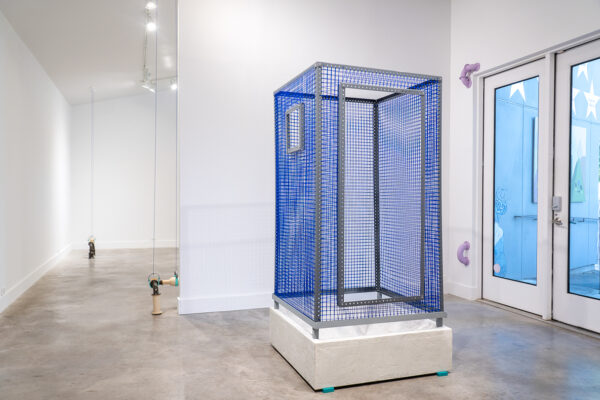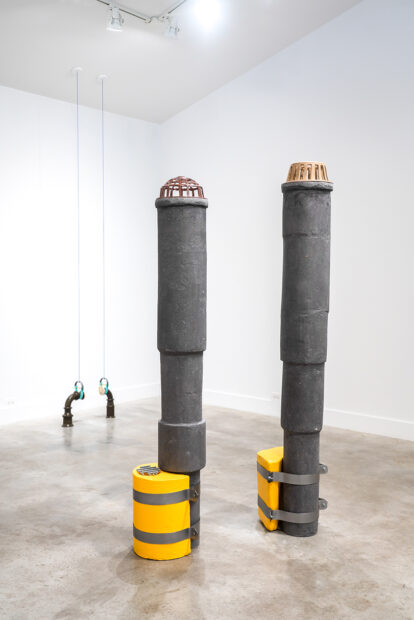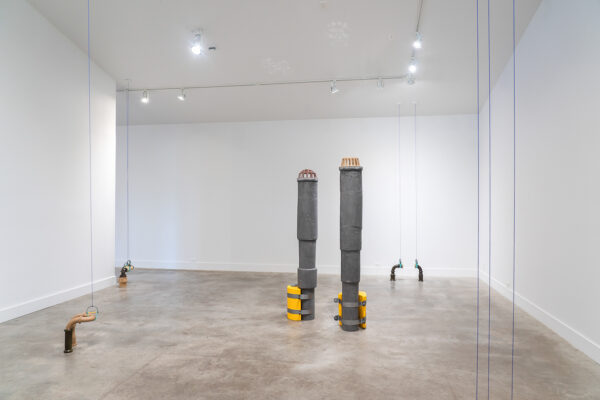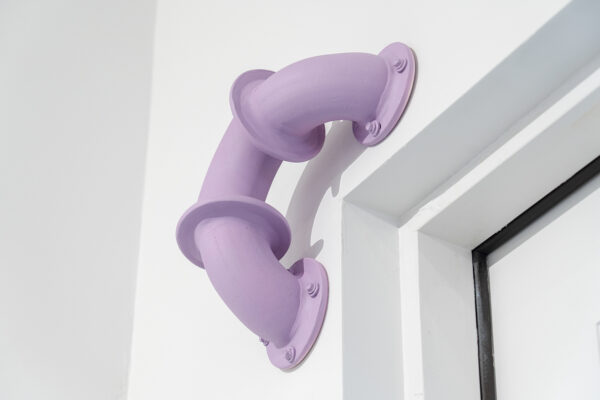I’ve only made two etchings in my life, both of which were mandatory for a printmaking class. While I think of this process as one that requires a patience that I don’t have, it seems like Ariel Wood does. Copper plate etching is a layered and clearly scientific process that involves covering a thin piece of copper in waxy black goo, carving into it with something needle-sharp, and submerging that plate into an acid bath. The acid burns away the parts of the copper that were exposed by the carving. Then you can remove the goo altogether, revealing a copper plate full of cuts, erosions, and little abrasions.
At this point, I think it’s productive to shrink yourself, reader, to a near-microscopic scale, which will allow you to envision yourself as an inhabitant of the copper plate, which is now your landscape. The various depressions in the plate are like canyons, crevasses, or tinajas (those strange concavities in bedrock that fill up with water and tadpoles when it rains). And when artist Ariel Wood sweeps watery blue ink across the plate, the depressions fill up and the abrasions become little pools, repositories. To print with this plate, Wood carefully presses a sheet of paper onto it, and the paper soaks the ink up like a rag. The etching process is really all about controlling liquid.
It’s not just the process that resonates with the themes in raze at grayDUCK Gallery, though. Entering through the gallery’s front door, a set of copper plate etchings line the leftmost wall like those chevron signs delineating a curve in the road ahead. Each one is an exacting blue depiction of an outdoor scene rendered in smoothly curving lines and soft tones, and each includes imagery of civic infrastructure, like manhole covers and sewage pipes. One reason why these feel like road signage is because they show the world that one can expect to enter as one makes their way past the etchings and into the rest of the exhibition.
Whenever Wood introduces this exhibition to people, they say they like words that mean two things. The exhibition design of raze feels like a spectrum that’s been carefully calculated to engage the senses, starting with the visual, moving into the bodily, and extending into the spatial or architectural.
Midway through the shotgun-style gallery (halfway through the spectrum), there’s a vertical sculpture made of woven blue twine walls strung along powder-coated steel angles, set atop an off-white basin cast in plaster and paper pulp, and outfitted with a drain in the center. The whole thing feels like a public shower stall. Strangely, the believability of the shower-like situation is entirely discounted, made into a sort of shower-prop, thanks to the inclusion of four acid-green rubber shims that elevate the sculpture about two inches off the ground. I look up and see no shower head — only the gallery ceiling infrastructure, lighting tracks and all. In doing so, I notice a lavender purple pipe coming out of the wall, curving considerately around the corner of the gallery’s back door. If this is a shower, then I suppose that’s where it gets its water.
Here is a cool trick: Wood often installs artworks on the surface of the gallery’s walls and floors, just as one would normally install a painting or etching or drawing. But because these artworks are shaped like pipes, they force me to imagine that there is a vast and unseen network of infrastructural waterways beyond the now penetrable surface of the walls. I imagine the entire gallery space as a dimensional thing, a thin skin past which there is an invisible reticulation of ducts, hoses, and channels conveying liquids — abject sewage, precious water, or some secret third thing? That a form simply applied to the surface of the gallery can actually begin to recast the material standing of the entire space is an optimistic and radical suggestion that we possess agency — or that we can at least imagine that we do — in spaces that seem to encapsulate us.
And when you consider that some writers like Robyn Longhurst think about liquid as a material with political significance, the forms in this exhibition resonate in profound ways. Our bodies’ abject fluids — tears, sweat, saliva — are so often hidden, controlled, or ignored, and Longhurst sees this as a societal practice that keeps rigidity, singularity, and masculinism intact.
Entering the last room of the gallery (the end of the spectrum), I notice the difference between what it feels like to look at a sculpture versus what it feels like to look at an installation. A sculpture is the focal point around which the viewer’s body orbits, but in an installation the objects are situated spatially around the viewer, and the viewer becomes the focal point. We’re in an installation now.
My eyes rest on these ceramic cylinders and drooping pipe forms peppered across the floor. Their roundness is delicately cradled in green rubber stirrups that connect to that familiar blue twine. Following the twine up to the ceiling, I become aware of the weight of these pipes, because the tension makes perfectly vertical lines in space. Here, the pipes that should seem to penetrate the room are less sturdy, less independently reliable than the lavender purple pipes seen earlier in the gallery; they rely on the ceiling for support, and their speckly brown material feels less industrial and more related to handmade stoneware crock pots or coffee mugs.
Towering in the middle of the room is a set of giant, precarious vertical tube forms with little rounded cages covering their top openings, and I am reminded of the depiction of these forms in one of the etchings I saw earlier. They’re so precarious, in fact, that they need to be strapped to construction-yellow ballasts, which makes sense, because in the etching these forms were shown to be underground; they were only made visible because all the soil around them had been dug up. With the landscape exhumed from around them, they become awkward, nearly figural things whose looming proximity to the delicate objects on the floor inspires an ambient anxiety.
If these old pipes are usually buried underground, perhaps I, the viewer, am in a pit. I imagine that I’m in a pit and that the surface of the ground is actually about a foot above my head. Down here, the timescale is geologic. And the crisp blue twine and bright green rubber stirrups that issue down from the ceiling to support the pipes around my feet, as well as the construction-yellow ballasts, in fact come from a more nascent and recent timescale. Therefore, I don’t really see these final sculptures as clever penetrations into the gallery, though they do involve the architecture — that just feels too strong. I actually see them here as the opposite — as anachronistic, outdated attempts to cover and to control the flow of water. And these attempts have contemporarily been bolstered and retrofitted with bright, plastic-y supports.
Even though sculpture isn’t often considered a time-based medium, raze as an exhibition is designed in such a way that the chronology is necessarily a part of one’s experience moving down the long gallery space. This, in conjunction with the strange material dissonances in the back room of the gallery, shows the artist’s complicated and ongoing relationship to liquid, the vessels that humans have long contained it in, and the rubbers we use to protect ourselves from it.
Ariel Wood: raze is on view at grayDUCK Gallery in Austin through October 1, 2023.







